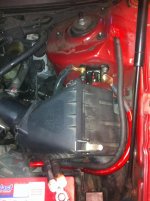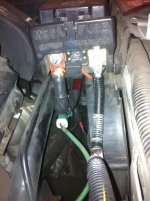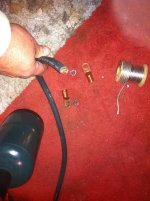I understand that completly and no im not trying to pick a fight with you not on here to post dump..
Everyone has there opinions and thats fine .. not everyone will agree with eachother..
In my opinion i wouldnt use a cap i would use a good battery like a BATCAP
Ive alwyas had good luck with them ...
Since i ran optima's and my voltage went from 14.8 down to 11.5 ..
I then upgraded to 2 batcap 4000's a high ouput alt and 0 guage wire and havent had a problem my voltage doesnt drop below 13.8 volts
Nah I respect your advice. You're probably a lot older than me, I'm still only going to college for this stuff. But I just recently did a big 3 upgrade/ alternator/ serpentine belt upgrade..Only reason I was offering my 2 cents in. But then putting a system in a 1995 buick skylark = way over board...but anyways. Forgot to mention...when upgrading your alternator...get the right belt size...sometimes your have to downsize your belt.
Speaking on capacitors possibly being more harm than benefit. Depending on the usage. If your a bass-head and your intention is to rattles fellow drivers windows. In an spl situation a whetr the electrical system is almost contantly stressed. Cap
s are the wrong piece of equipment to use. Caps discharge very quickly and eaisly under a constant load. Once this happens the cap is a load until it recharges. Caps require alot of current once they have become depleted, this current load is transfered to the alternater and can shorted the life of any alternator. This transferable current load increases with every increase in farad that is added. The proper use of caps is to tweak a proper working electrical system, transfering spontanous current to amps, which due to the internal resistance batteries caps are better performing this. Hope this helps
s are the wrong piece of equipment to use. Caps discharge very quickly and eaisly under a constant load. Once this happens the cap is a load until it recharges. Caps require alot of current once they have become depleted, this current load is transfered to the alternater and can shorted the life of any alternator. This transferable current load increases with every increase in farad that is added. The proper use of caps is to tweak a proper working electrical system, transfering spontanous current to amps, which due to the internal resistance batteries caps are better performing this. Hope this helps
Speaking on capacitors possibly being more harm than benefit. Depending on the usage. If your a bass-head and your intention is to rattles fellow drivers windows. In an spl situation a whetr the electrical system is almost contantly stressed. Cap
s are the wrong piece of equipment to use. Caps discharge very quickly and eaisly under a constant load. Once this happens the cap is a load until it recharges. Caps require alot of current once they have become depleted, this current load is transfered to the alternater and can shorted the life of any alternator. This transferable current load increases with every increase in farad that is added. The proper use of caps is to tweak a proper working electrical system, transfering spontanous current to amps, which due to the internal resistance batteries caps are better performing this. Hope this helps
s are the wrong piece of equipment to use. Caps discharge very quickly and eaisly under a constant load. Once this happens the cap is a load until it recharges. Caps require alot of current once they have become depleted, this current load is transfered to the alternater and can shorted the life of any alternator. This transferable current load increases with every increase in farad that is added. The proper use of caps is to tweak a proper working electrical system, transfering spontanous current to amps, which due to the internal resistance batteries caps are better performing this. Hope this helps
Speaking on capacitors possibly being more harm than benefit. Depending on the usage. If your a bass-head and your intention is to rattles fellow drivers windows. In an spl situation a whetr the electrical system is almost contantly stressed. Cap
s are the wrong piece of equipment to use. Caps discharge very quickly and eaisly under a constant load. Once this happens the cap is a load until it recharges. Caps require alot of current once they have become depleted, this current load is transfered to the alternater and can shorted the life of any alternator. This transferable current load increases with every increase in farad that is added. The proper use of caps is to tweak a proper working electrical system, transfering spontanous current to amps, which due to the internal resistance batteries caps are better performing this. Hope this helps
Well said =}
This all good advice, thank you. I will start with the big 3, and 0 or 2ga. pwr. wire to the trunk and see what happens.
4 gauge for the big 3...2gauge is for the insurance....0gauge is kinda overkill lol. But id recommend any of them. Its up to you. Id recommend 0gauge to the trunk just incase you ever want to upgrade. Id also recommend welding cable in which you can buy really cheap at weldingsupplies.com. its a true 0gauge. And it works perfect for any type of power. If you want to go for the expensive 0gauge. Id advise knukoncept 0 gauge or kicker 0 gauge. I got knukoncept and that wire is $79 off amazon for 17' and 5ft of ground wire which you can use for your amp and still have a little bit more to use for part of your big 3 upgrade. But the choice is yours. These are just my recommendations and I take some of these opinions from perry...who knows what.he is talkin about. Gl with your system...pound like a beast on them roads someguy. ; )
I don't know a lot about car audio, Or the type and age of your car, but as a car guy I was always looking for 14+ volts for max voltage from my ignition system. Most alternators output over 14 volts. Check out this link for a better explanation then I could ever give on how to get all of this voltage.
Catalog
Hope it helps....Evan
Catalog
Hope it helps....Evan
-Highest current alternator you can find that will fit correctly
-two 2 gauge cables / grounds from engine to body
-2 gauge wire from the alternator to the battery, then 0gauge from the battery to the amp area. Split into the gauges the amps will accept as long as they are a short distance (1 foot or so) from the splitter. Ground the amps with the thickest they will accept and the shortest length that will reach a solid thick piece of vehicle ground metal.
This is just a guideline for a vehicle running a couple of thousand rms, some people go bigger and better and some run less. It all depends on your required current capability. The distances between components also determines how thick the cable should be.
-two 2 gauge cables / grounds from engine to body
-2 gauge wire from the alternator to the battery, then 0gauge from the battery to the amp area. Split into the gauges the amps will accept as long as they are a short distance (1 foot or so) from the splitter. Ground the amps with the thickest they will accept and the shortest length that will reach a solid thick piece of vehicle ground metal.
This is just a guideline for a vehicle running a couple of thousand rms, some people go bigger and better and some run less. It all depends on your required current capability. The distances between components also determines how thick the cable should be.
Pia600....check out the link I posted. The voltage sense wire needs to be connected closer to the amps. Bigger wire from the alternator to the battery won't do it.
Pia600....check out the link I posted. The voltage sense wire needs to be connected closer to the amps. Bigger wire from the alternator to the battery won't do it.
I've heard of people doing it but haven't tried so I'm not sure how safe it is. It is pretty clever though. Basically tricking the alternator into thinking it isn't producing enough voltage so it regulates higher.
That's how I did mine. Except my car was different. Instead of having the wire go from the alt to the battery, it went from the battery to the starter.to the alt. So I ran two 4gauge wires from the alt to the starter...thus producing more amps. Works like a charm
All my other wire is 0 gauge and the wire from the positive.to the starter is 0gauge
All my other wire is 0 gauge and the wire from the positive.to the starter is 0gauge
Last edited:
You have to be careful if you move the voltage sense wire. If it's on the other side of a fuse and you get either a bad connection or a blown fuse, the voltage to the front battery and the rest of the vehicle can be fairly high. I've seen it over 17v on some of the GM alternators that developed a bad connection on the alternator connections (2-pin connector on the top of the alternator).
What's the worst that could happen......burned out electronics....exploding battery.........yes be careful.
Oh I seen a truck on fire on the hwy due to bad wiring. It is no joke when they say be careful and wire your stuff.right. I didn't.take chances. I bought all my wires and took it.to a mechanic and had them do it. Figured.out it was worth it. All my grounds were almost shorted out and would've caused a fire if I didnt upgrade it. So installing my new alt and big 3 upgrade...saved my car. And myself
Last edited:
If you're going for a high power system run a dedicated earth to the battery-it will make a difference, there's good reason all the SPL guys do it.
If you're going for a high power system run a dedicated earth to the battery-it will make a difference, there's good reason all the SPL guys do it.
This definitely helps. I have 1 0 gauge ground and 3 4 gauge grounds.
Just realized my (and several others') suggestion of using substantially thicker alternator and amp wiring would bring the alternator output terminal voltage closer to amp input terminal voltage, so the alternator would also be able to respond quicker / in a similar manner to connecting the voltage sense wire in the rear. Having a thin alternator cable and thin engine, battery, chassis grounds will act as a buffer between the alternator sense circuit and amplifier location so the alternator may be producing 14 volts but the resistance of the wiring will always yield a lower voltage at the other end due to load.
Pia600....check out the link I posted. The voltage sense wire needs to be connected closer to the amps. Bigger wire from the alternator to the battery won't do it.
Evanc,
The link you posted on the (alternator sencer wire) takes you to a funature site. Nice stuff, but nothing on this topic. Do you have more information on this somewhere?_
I was feeling really good about all this until, I read that none of this matters unless I move the alternator sencer closer to the amps! how true is this?_
Currently I am in the middle of my Big 3. Yesterday, I had a piece of 0gauge Audiopipe wire that I used to run from my batt+ to a (under hood) 140a breaker that will run to my amp rack in the trunk. Then (same wire) from batt+ to the 175amp alternator fuse on the fusebox. From the fuse to the alternator I am running 1/0 pure copper welding cable. I also used the welding cable for my ground wires (Neg post to frame, and Neg post to engine block). Today, I plan on finishing this up by running another wire from engine block to the frame. I still have the stock 4ga. powerwire running from the starter to the batt+, I will have to get a different battery teminal to upgrade this wire to the heavy stuff due to the large gauge wires already on the terminal. I am sure that this is overkill for my stereo system but, Overkill is my style, and gives me confidence and reliability. All wires lugs are fluxed and silver soldered together (no cold joints, and no Crimps).
Is all this really pointless w/o moving the sencer??????
Please advise, Matt
The link you posted on the (alternator sencer wire) takes you to a funature site. Nice stuff, but nothing on this topic. Do you have more information on this somewhere?_
I was feeling really good about all this until, I read that none of this matters unless I move the alternator sencer closer to the amps! how true is this?_
Currently I am in the middle of my Big 3. Yesterday, I had a piece of 0gauge Audiopipe wire that I used to run from my batt+ to a (under hood) 140a breaker that will run to my amp rack in the trunk. Then (same wire) from batt+ to the 175amp alternator fuse on the fusebox. From the fuse to the alternator I am running 1/0 pure copper welding cable. I also used the welding cable for my ground wires (Neg post to frame, and Neg post to engine block). Today, I plan on finishing this up by running another wire from engine block to the frame. I still have the stock 4ga. powerwire running from the starter to the batt+, I will have to get a different battery teminal to upgrade this wire to the heavy stuff due to the large gauge wires already on the terminal. I am sure that this is overkill for my stereo system but, Overkill is my style, and gives me confidence and reliability. All wires lugs are fluxed and silver soldered together (no cold joints, and no Crimps).
Is all this really pointless w/o moving the sencer??????
Please advise, Matt
Attachments
All of it is important, having larger gauge wire in essence moves the alternator sense circuit closer to the amps. It brings amp voltage closer to alternator voltage. You could connect the sense wire on the amp end but if your power wire is thick enough to negate the voltage difference front to back, it wouldn't be necessary. Upgrading the starter wire would only get the starter higher voltage, woudn't help the audio system unless the starter was in the middle of the alternator to battery circuit. (alternator > starter > battery)
Last edited:
sure, but depends on your alt's regulator, some of them are really slow, and bigger wire won't help much
- Status
- Not open for further replies.
- Home
- General Interest
- Car Audio
- Best way to get a true 14.4vdc to my amp under load


